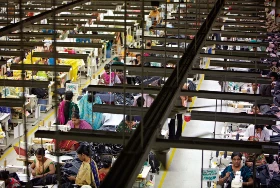
Economic growth in the last two decades in Bangladesh has been pro-poor. Poverty declined significantly from 58.8 percent in 1991/92 to 31.5 percent in 2010. Bangladesh succeeded in “bending the arc of poverty reduction” in the decade ending 2010, a period in which the number of poor declined by around 15 million, compared with a decline of about 2.3 million in the preceding decade. There has also been regional convergence in poverty patterns during 2005-10. Poverty reduction in the lagging Western divisions (Rajshahi, Khulna, and Barisal) was larger than in the Eastern divisions. A number of other indicators of welfare also show notable improvements between 2000 and 2010 for the general population and the poor alike.
Income distribution stabilized after deteriorating in the 1990s. While comparisons based on consumption data have been used to argue that inequality in Bangladesh is low by international standards, when income rather than HIES consumption data are used, inequality appears to be much higher. The degree of income inequality was reasonably low and stable compared to countries such as Malaysia, Thailand and Philippines during the 1970s and 1980s. But there was a sharp increase between 1991-92 and 1995-96. Gini consumption concentration ratios based on HIES 2000, 2005, and 2010 data were almost unchanged while Gini income concentration ratios increased by 3.5 percent during 2000-05 followed by 1.9 percent decrease during 2005-10. The good news is it has been a race to the top in the past decade with consumption growing for the poor and non-poor alike. However, income inequality in Bangladesh is relatively high. Among Bangladesh’s peer group of countries only Sri Lanka has a higher income Gini and Cambodia is close.
Inclusivity of opportunities has improved over time. Labor is the single most important endowment of the poor. The good news is that average employment opportunity to Bangladeshis has increased over time reflecting a surge in migration abroad in the last half of the past decade. Also the distribution of employment opportunities has remained pro-poor. The bad news is that domestic employment opportunities have become less inclusive over time due to decline in both average employment opportunities as well as the distribution of employment opportunities. The decline in the inclusiveness of domestic employment was exacerbated by decline in the inclusiveness of access to land. Access to education, health and electricity continue to remain inequitable – electricity highly so; but inclusivity has improved over time on all the three indicators due to both increase in average opportunity as well as the distribution of opportunities.
No room for complacence. The size of the vulnerable non-poor remains very large. Simply moving from the national poverty line of $1.09 a day to the international $1.25 a day line increases the headcount ratio from 31.5 percent to 43.3 percent. The observed pace of poverty reduction in the last two decades slows considerably with the raising of the poverty line. Large numbers are at the margin (48.4 million above $1.25 a day but below $2 a day), indicating potential vulnerability to idiosyncratic or covariate shocks to income and/or expenditures. Vulnerability varies by regions and household characteristics. Vulnerability in coastal divisions (Rangpur, Chittagong) is much higher than the rest of the country. Vulnerability tends to be highest among households headed by illiterate persons. Households headed by persons with more than ten years of education are better placed to cope with risk and uncertainty. Also, agricultural households are more vulnerable than non-agricultural households. Bangladesh’s experience demonstrates that the notion of inclusion is no illusion, but it needs persistent policy attention to enhance access of the poor to economic opportunities.


Join the Conversation